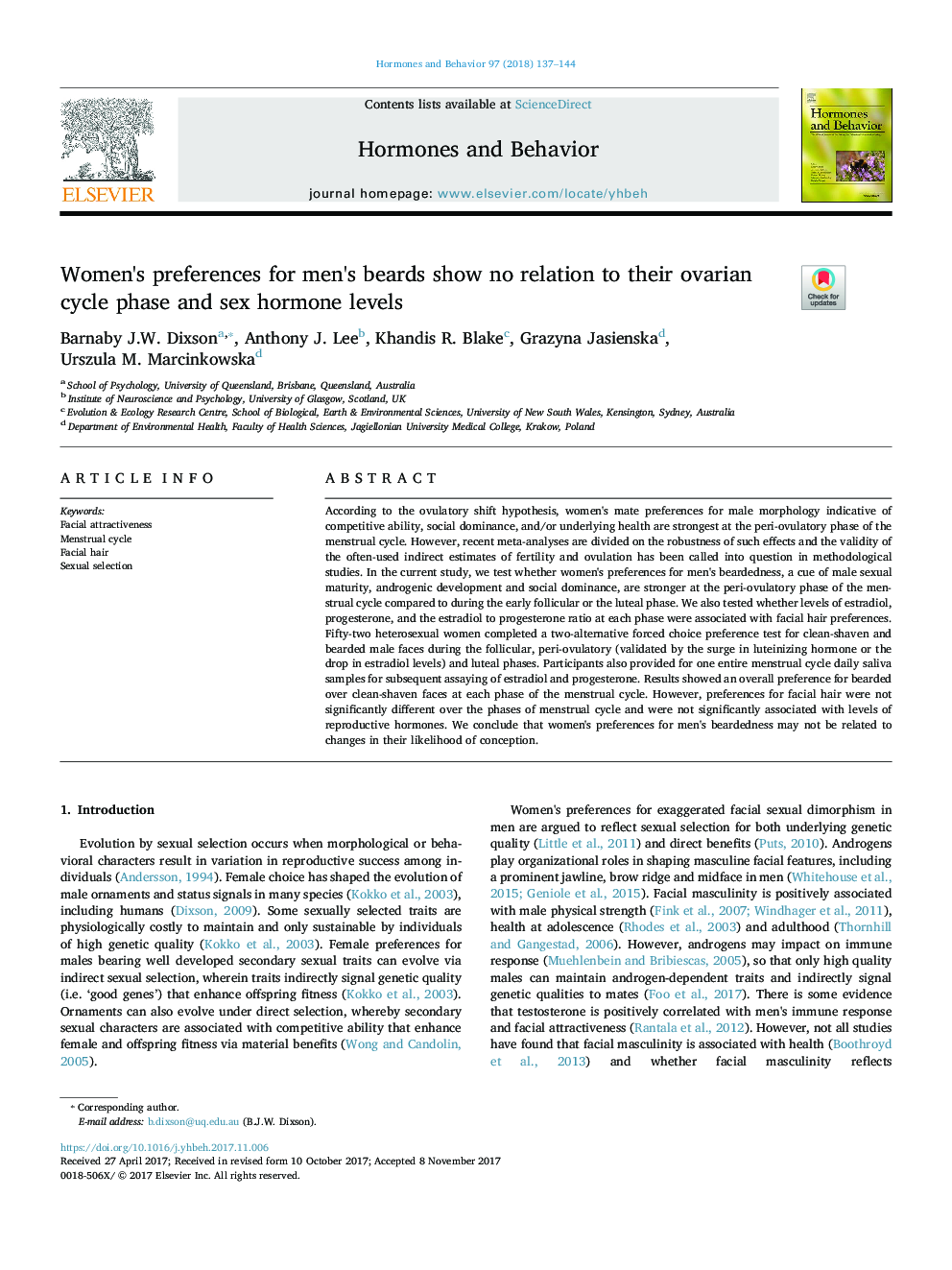| کد مقاله | کد نشریه | سال انتشار | مقاله انگلیسی | نسخه تمام متن |
|---|---|---|---|---|
| 6794195 | 1432743 | 2018 | 8 صفحه PDF | دانلود رایگان |
عنوان انگلیسی مقاله ISI
Women's preferences for men's beards show no relation to their ovarian cycle phase and sex hormone levels
ترجمه فارسی عنوان
ترجیحات زنان برای ریش مردان ارتباطی با مرحله چرخه تخمدان و سطح هورمون جنسی ندارد
دانلود مقاله + سفارش ترجمه
دانلود مقاله ISI انگلیسی
رایگان برای ایرانیان
کلمات کلیدی
جذابیت صورت، چرخه قاعدگی، موی صورت، انتخاب جنسی،
ترجمه چکیده
با توجه به فرضیه تغییر شکل تخمک گذاری، ترجیحات همسر زنان برای مورفولوژی مردانه نشان دهنده توان رقابتی، سلطه اجتماعی و / یا سلامت پایه در مرحله فیزیولوژیک چرخه قاعدگی است. با این حال، متاآنالیزهای اخیر بر پایداری این اثرات تقسیم می شوند و اعتبار تخمین های غیرمستقیم اغلب استفاده شده از باروری و تخمک گذاری در مطالعات روش شناختی مطرح شده است. در مطالعه حاضر، ما بررسی می کنیم که آیا ترجیحات زنان برای ریشخوانی مردان، نشانه بلوغ جنسیت مرد، توسعه آندروژنیک و سلطه اجتماعی، در فاز پریووالیته چرخه قاعدگی در مقایسه با فاز اولیه فولیکولار یا فاز لوتئال قوی تر است. ما همچنین آزمایش کردیم که آیا میزان استرادیول، پروژسترون و استرادیول به نسبت پروژسترون در هر مرحله با تنظیمات موی صورت ارتباط دارد. پنجاه و دو زن دگرجنسگرانه آزمودنی های دو گزینه ای را برای چهره های تمیز پوست و ریشی در طول فولیکولار، پریووالواتور (که توسط افزایش هورمون لوتئینیزه یا کاهش میزان استرادیول) و فاز لوتئال تایید شده بود، انجام داد. شرکت کنندگان همچنین برای یک چرخه قاعدگی روزانه بزاق نمونه ها را برای بررسی ادرارآور و پروژسترون فراهم کردند. نتایج در هر مرحله از چرخه قاعدگی، ترجیح کلی برای ریش موهای چهره پاکیزه را نشان داد. با این حال، ترجیحات برای موهای صورت در فصول چرخه قاعدگی به طور قابل توجهی متفاوت نیست و به طور قابل توجهی با سطوح هورمون های تولید مثل ارتباط نداشت. ما نتیجه می گیریم که ترجیحات زنان برای ریشخوانی مردان ممکن است به تغییرات احتمال ابتلای آنها بستگی داشته باشد.
موضوعات مرتبط
علوم زیستی و بیوفناوری
بیوشیمی، ژنتیک و زیست شناسی مولکولی
علوم غدد
چکیده انگلیسی
According to the ovulatory shift hypothesis, women's mate preferences for male morphology indicative of competitive ability, social dominance, and/or underlying health are strongest at the peri-ovulatory phase of the menstrual cycle. However, recent meta-analyses are divided on the robustness of such effects and the validity of the often-used indirect estimates of fertility and ovulation has been called into question in methodological studies. In the current study, we test whether women's preferences for men's beardedness, a cue of male sexual maturity, androgenic development and social dominance, are stronger at the peri-ovulatory phase of the menstrual cycle compared to during the early follicular or the luteal phase. We also tested whether levels of estradiol, progesterone, and the estradiol to progesterone ratio at each phase were associated with facial hair preferences. Fifty-two heterosexual women completed a two-alternative forced choice preference test for clean-shaven and bearded male faces during the follicular, peri-ovulatory (validated by the surge in luteinizing hormone or the drop in estradiol levels) and luteal phases. Participants also provided for one entire menstrual cycle daily saliva samples for subsequent assaying of estradiol and progesterone. Results showed an overall preference for bearded over clean-shaven faces at each phase of the menstrual cycle. However, preferences for facial hair were not significantly different over the phases of menstrual cycle and were not significantly associated with levels of reproductive hormones. We conclude that women's preferences for men's beardedness may not be related to changes in their likelihood of conception.
ناشر
Database: Elsevier - ScienceDirect (ساینس دایرکت)
Journal: Hormones and Behavior - Volume 97, January 2018, Pages 137-144
Journal: Hormones and Behavior - Volume 97, January 2018, Pages 137-144
نویسندگان
Barnaby J.W. Dixson, Anthony J. Lee, Khandis R. Blake, Grazyna Jasienska, Urszula M. Marcinkowska,
